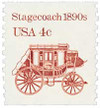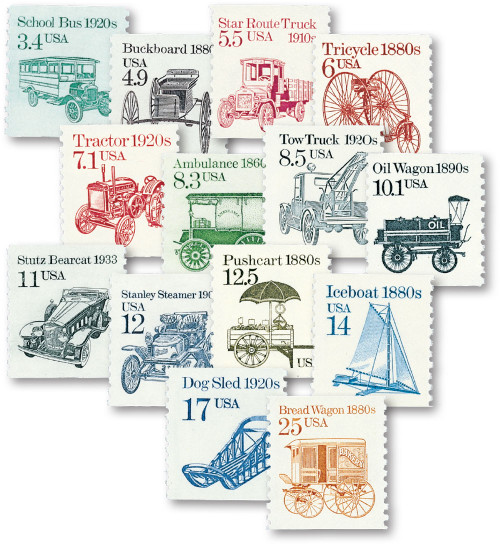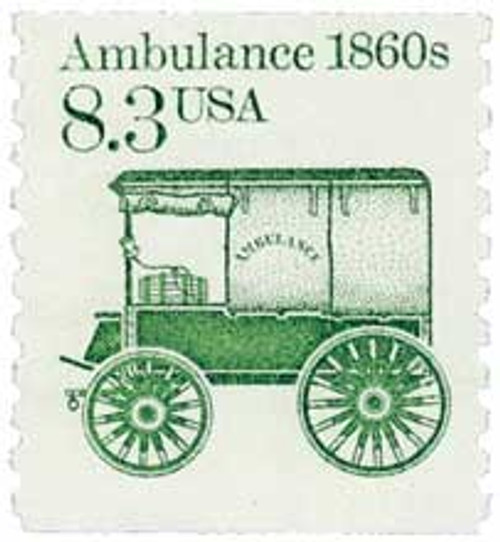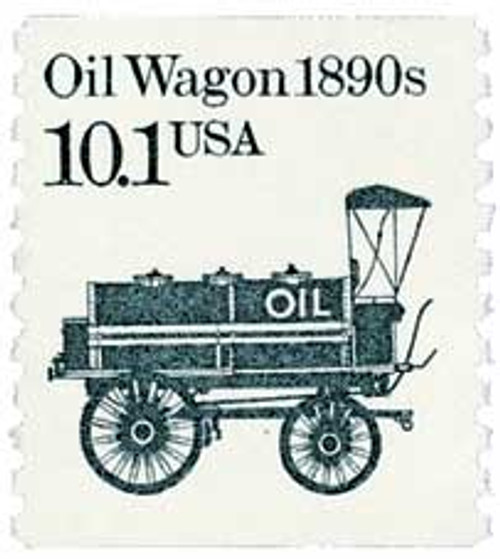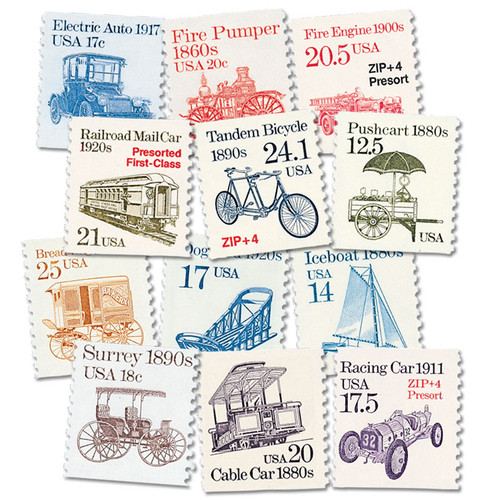
# 2228 - 1986 4c Transportation Series: Stagecoach, 1890s, re-engraved
U.S. #2228
1986 4¢ Stagecoach, 1890s, re-engraved
Transportation Series
- First re-engraved Transportation Coil printed on the B Press
Stamp Category: Definitive
Series: Transportation
Value: 4¢, paid for change-making in vending machines and the rate for five-digit non-profit presorted mailings
First Day of Issue: August 15, 1986
First Day City: Washington, DC
Quantity Issued: 29,472,000
Printed by: Bureau of Engraving and Printing
Printing Method: Engraved
Format: Coils of 3,000
Perforations: 10 Vertical
Color: Reddish brown
Why the stamp was issued: Several of the early Transportation stamps had been printed on the Cottrell presses, which were no longer in use. Over time, they needed to print more stamps of certain denominations. When possible, they reused the same master die. But some stamps with designs larger than .73 inches needed to be re-engraved. This Stagecoach stamp was among those to be re-engraved. The new stamp had several small differences from the original stamp.
About the stamp design: US #2228 features the same design as the 1982 Stagecoach stamp, US #1898A, with artwork by James Schleyer. This revised version retained the cent sign and kept the "USA" in front of the denomination. However, the stagecoach design and lettering were made smaller. The color also appeared deeper on the 1982 stamp because of the deeper engraving on the Cottrell press. The tagging was also different on both versions of the stamp. The 1982 stamps had overall tagging (including the perforations) while the 1986 stamp had block-over-vignette tagging.
First Day City: The USPS didn’t plan a First Day ceremony for this stamp, nor did they announce an official release date beforehand. They simply stated that the stamp would appear on sale at some point. Knowing the stamp was coming, some cachet makers visited the philatelic sales counter at the USPS headquarters in Washington frequently, hoping to get the stamp the first day it was placed on sale. Only about 500 covers are known to exist from the first day of sale at the Washington post office, making First Day covers for this stamp quite rare by modern standards.
Unusual fact about this stamp: Varieties have been found with overall tagging and imperforate.
About the Transportation Series: On May 18, 1981, the USPS issued the first stamp in the Transportation Series, US #1907, picturing the Surrey, a doorless four-wheeled carriage. For the first time in US history, a coil stamp featured its own unique design rather than simply copying that of the current definitive stamp. Over 50 more coil stamps would be issued over the course of the next 15 years, each picturing a different mode of transportation. All of these types of transportation were used since American independence.
The various denominations provided face values to exactly match the rates for several categories of Third-Class mail (bulk rate and quantity-discounted mail). As the rates changed, new stamps with new values were added. Never before had a stamp series included so many fractional cent values.
The Bureau of Engraving and Printing printed most of the stamps in the Transportation Series, although private contractors printed a few. All but a few of the later stamps were produced by engraved intaglio. Differences in precancels, tagging, paper and gum provide a large number of varieties.
Scott Catalog separates the Transportation stamps into four groups. The stamps in the first group (#1897-1908) generally have the denomination in small type with a “c” next to it. These stamps were printed on the Cottrell rotary press, which joined together two plates to make a sleeve. The gaps between these plates created depressions where ink would collect and create joint lines on the stamps. Later issues were printed on a different press and didn’t have these joint lines.
The second group (#2123-36) had larger numbers with no “c.” The third group (#2252-66) was similar in appearance to the second group, but service inscriptions were added to the designs. These stamps also used a variety of paper and gum as well as different types of tagging. The fourth group (#2451-68) marked the end of fractional values. Now bulk mailers would use either the 5¢ or 10¢ stamp and then pay the difference from the actual postage rate.
The last stamp in the Transportation Series, the 20¢ Cog Railway, was issued on June 9, 1995, at the TEXPEX ’95 stamp show in Dallas, Texas. This marked the end of the largest US definitive series up to that time. Three new series would eventually replace it – American Transportation, American Culture, and American Scenes. Additionally, the Great Americans would go on to become the largest American definitive series.
History the stamp represents: During the 1700s and 1800s, the stagecoach traveled along regular routes carrying passengers and mail. Lines were established in colonial America as early as 1756 between the chief cities of Boston, New York, and Philadelphia. Other routes were gradually added on the East Coast, and lines were even established out West. Eventually, railroads took the place of this popular form of transportation.
U.S. #2228
1986 4¢ Stagecoach, 1890s, re-engraved
Transportation Series
- First re-engraved Transportation Coil printed on the B Press
Stamp Category: Definitive
Series: Transportation
Value: 4¢, paid for change-making in vending machines and the rate for five-digit non-profit presorted mailings
First Day of Issue: August 15, 1986
First Day City: Washington, DC
Quantity Issued: 29,472,000
Printed by: Bureau of Engraving and Printing
Printing Method: Engraved
Format: Coils of 3,000
Perforations: 10 Vertical
Color: Reddish brown
Why the stamp was issued: Several of the early Transportation stamps had been printed on the Cottrell presses, which were no longer in use. Over time, they needed to print more stamps of certain denominations. When possible, they reused the same master die. But some stamps with designs larger than .73 inches needed to be re-engraved. This Stagecoach stamp was among those to be re-engraved. The new stamp had several small differences from the original stamp.
About the stamp design: US #2228 features the same design as the 1982 Stagecoach stamp, US #1898A, with artwork by James Schleyer. This revised version retained the cent sign and kept the "USA" in front of the denomination. However, the stagecoach design and lettering were made smaller. The color also appeared deeper on the 1982 stamp because of the deeper engraving on the Cottrell press. The tagging was also different on both versions of the stamp. The 1982 stamps had overall tagging (including the perforations) while the 1986 stamp had block-over-vignette tagging.
First Day City: The USPS didn’t plan a First Day ceremony for this stamp, nor did they announce an official release date beforehand. They simply stated that the stamp would appear on sale at some point. Knowing the stamp was coming, some cachet makers visited the philatelic sales counter at the USPS headquarters in Washington frequently, hoping to get the stamp the first day it was placed on sale. Only about 500 covers are known to exist from the first day of sale at the Washington post office, making First Day covers for this stamp quite rare by modern standards.
Unusual fact about this stamp: Varieties have been found with overall tagging and imperforate.
About the Transportation Series: On May 18, 1981, the USPS issued the first stamp in the Transportation Series, US #1907, picturing the Surrey, a doorless four-wheeled carriage. For the first time in US history, a coil stamp featured its own unique design rather than simply copying that of the current definitive stamp. Over 50 more coil stamps would be issued over the course of the next 15 years, each picturing a different mode of transportation. All of these types of transportation were used since American independence.
The various denominations provided face values to exactly match the rates for several categories of Third-Class mail (bulk rate and quantity-discounted mail). As the rates changed, new stamps with new values were added. Never before had a stamp series included so many fractional cent values.
The Bureau of Engraving and Printing printed most of the stamps in the Transportation Series, although private contractors printed a few. All but a few of the later stamps were produced by engraved intaglio. Differences in precancels, tagging, paper and gum provide a large number of varieties.
Scott Catalog separates the Transportation stamps into four groups. The stamps in the first group (#1897-1908) generally have the denomination in small type with a “c” next to it. These stamps were printed on the Cottrell rotary press, which joined together two plates to make a sleeve. The gaps between these plates created depressions where ink would collect and create joint lines on the stamps. Later issues were printed on a different press and didn’t have these joint lines.
The second group (#2123-36) had larger numbers with no “c.” The third group (#2252-66) was similar in appearance to the second group, but service inscriptions were added to the designs. These stamps also used a variety of paper and gum as well as different types of tagging. The fourth group (#2451-68) marked the end of fractional values. Now bulk mailers would use either the 5¢ or 10¢ stamp and then pay the difference from the actual postage rate.
The last stamp in the Transportation Series, the 20¢ Cog Railway, was issued on June 9, 1995, at the TEXPEX ’95 stamp show in Dallas, Texas. This marked the end of the largest US definitive series up to that time. Three new series would eventually replace it – American Transportation, American Culture, and American Scenes. Additionally, the Great Americans would go on to become the largest American definitive series.
History the stamp represents: During the 1700s and 1800s, the stagecoach traveled along regular routes carrying passengers and mail. Lines were established in colonial America as early as 1756 between the chief cities of Boston, New York, and Philadelphia. Other routes were gradually added on the East Coast, and lines were even established out West. Eventually, railroads took the place of this popular form of transportation.



